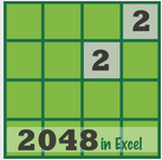It wasn't long before I noticed that screen updating hasn't been turned-off. The analyst was aware of the application setting, but opted not to disable it, as he wanted to observe what his code was doing while Excel was tied-up for half-an-hour. Obviously, letting Excel update the screen only slows-down macro execution and worsens the problem. A progress bar is the ideal method of giving users an indication that a macro is progressing correctly.
Application.ScreenUpdating Property
Turn screen updating off to speed up your macro code and avoid screen-flicker. You won't be able to see what the macro is doing, but it will run much faster! There is no need to set the property back to True when your program ends, as Excel will automatically do so. The only time this property should not be disabled is when the user needs to observe screen activity, for example, during a game. Please feel free to review the code of the 2048 game in Excel.
Application.ScreenUpdating = False
Application.Calculation Property
When your VBA code changes cell values, Excel by default will recalculate all dependent cells. This behaviour can cause a workbook to recalculate several times during macro execution, which will degrade performance significantly. I have witnessed large models hang-up hopelessly or even crash Excel when macros are run with the xlCalculationAutomatic setting. Excel's automatic recalculation can be disabled by setting it to manual. Macros may execute in seconds or a few minutes, instead of hours.
Application.Calculation = xlCalculationManual
A word of caution: Excel won't update values in cells while calculation is manual. If you code relies on updated cell values, a Calculate event must be forced with the range, workbook or application .Calculate or Application.CalculateFull method.
If the Worksheet.EnableCalculation property is set to False, Excel will exclude the worksheet in any recalculation request by Sheet.Calculate, Application.Calculate, Application.CalculateFull and Application.CalculateFullRebuild. The .EnableCalculation property has no effect on Range.Calculate.
The Application.Calculation property must be reset by the program to its previous state before macro execution, otherwise incorrect values and conditional formats may be shown in Excel cells.
If the Worksheet.EnableCalculation property is set to False, Excel will exclude the worksheet in any recalculation request by Sheet.Calculate, Application.Calculate, Application.CalculateFull and Application.CalculateFullRebuild. The .EnableCalculation property has no effect on Range.Calculate.
The Application.Calculation property must be reset by the program to its previous state before macro execution, otherwise incorrect values and conditional formats may be shown in Excel cells.
Application.EnableEvents Property
Events are actions performed by users which trigger Excel VBA to execute code or by actions of other VBA code. Events can be suppressed, if not required. However, performance benefits are usually marginal.
In some circumstances, it may not be desirable to disable all event handling as your application may rely on various events to run properly. So, toggle this property with caution!
In some circumstances, it may not be desirable to disable all event handling as your application may rely on various events to run properly. So, toggle this property with caution!
Application.EnableEvents = False
Avoid Selecting Objects In VBA
Unfortunately, Macro Recorder doesn't create code in an efficient format. To write code that will execute fast, work directly with fully qualified objects without using .Select method.
Option Explicit Sub DoNotDoThis() Dim oSheet As Worksheet For Each oSheet In Worksheets oSheet.Activate Range("A1").Select Selection.Value = "Report" Selection.NumberFormat = "@" Next End Sub Sub DoThis() Dim oSheet As Worksheet Application.ScreenUpdating = False For Each oSheet In ActiveWorkbook.Worksheets With oSheet.Range("A1") .Value = "Report" .NumberFormat = "@" End With Next oSheet End Sub






